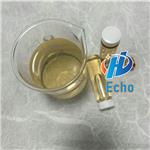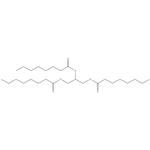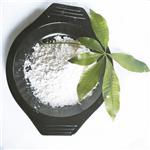TRIOCTANOIN
- CAS No.
- 538-23-8
- Chemical Name:
- TRIOCTANOIN
- Synonyms
- TRICAPRYLIN;GLYCEROL TRICAPRYLATE;GLYCERYL TRICAPRYLATE;Caprylic triglyceride;Tricaprilin;CAPRYLIN;TRICAPRYLIN (C8:0);Glycerol trioctanoate;Glyceryl tricaprylate-caprate;RATO
- CBNumber:
- CB8170985
- Molecular Formula:
- C27H50O6
- Molecular Weight:
- 470.68
- MDL Number:
- MFCD00036236
- MOL File:
- 538-23-8.mol
- MSDS File:
- SDS
| Melting point | 9-10 °C |
|---|---|
| Boiling point | 233 °C/1 mmHg (lit.) |
| Density | 0.956 g/mL at 20 °C (lit.) |
| vapor pressure | 0Pa at 25℃ |
| refractive index |
n |
| Flash point | 225 °C |
| storage temp. | -20°C |
| solubility | Miscible with most organic solvents including ethanol (95%). Captex 8000 is insoluble in water. |
| color | Colourless |
| Odor | at 100.00?%. odorless |
| Water Solubility | 65mg/L at 20℃ |
| BRN | 1717202 |
| LogP | 9.2 at 20℃ |
| CAS DataBase Reference | 538-23-8(CAS DataBase Reference) |
| EWG's Food Scores | 1 |
| FDA UNII | 6P92858988 |
| EPA Substance Registry System | Glycerol trioctanoate (538-23-8) |
TRIOCTANOIN price More Price(17)
| Manufacturer | Product number | Product description | CAS number | Packaging | Price | Updated | Buy |
|---|---|---|---|---|---|---|---|
| Sigma-Aldrich | T9126 | Glyceryl trioctanoate ≥99% | 538-23-8 | 100ml | $74.1 | 2024-03-01 | Buy |
| Sigma-Aldrich | T9126 | Glyceryl trioctanoate ≥99% | 538-23-8 | 1l | $404 | 2024-03-01 | Buy |
| TCI Chemical | T0365 | Tricaprylin >93.0%(GC) | 538-23-8 | 25mL | $47 | 2024-03-01 | Buy |
| Cayman Chemical | 26952 | 1,2,3-Trioctanoyl Glycerol | 538-23-8 | 50mg | $32 | 2024-03-01 | Buy |
| Cayman Chemical | 26952 | 1,2,3-Trioctanoyl Glycerol | 538-23-8 | 100mg | $57 | 2024-03-01 | Buy |
TRIOCTANOIN Chemical Properties,Uses,Production
Description
1,2,3-Trioctanoyl glycerol is a triacylglycerol that contains octanoic acid at the sn-1, sn-2, and sn-3 positions. Dietary administration of 1,2,3-trioctanoyl glycerol (260 g/kg diet) increases hepatic and adipose tissue glucose-6-phosphate dehydrogenase (G6PDH), citrate cleavage enzyme (CCE), and malic enzyme activities in rats. It induces nuclear edema and cytolysis in tumor cells, but not normal hepatic cells, in a murine hepatic carcinoma model.
Chemical Properties
clear colorless to yellow viscous liquid
Chemical Properties
Tricaprylin occurs as a clear, colorless to pale-yellow liquid. It forms crystals from acetone/ethanol (95%). Tricaprylin is odorless.
Uses
Glytex(R) 273 is a low viscosity polyol ester suggested for use as a synthetic fiber lubricant. It offers a balance of moderate volatility and low varnishing behavior. For low to moderate denier polyester and nylon filament and staple yarn applications. Product Data Sheet
Uses
tricaprylin is a skin-conditioning agent.
Uses
glyceryl trioctanoate is an emollient with skin-softening abilities.
Definition
ChEBI: A triglyceride obtained by acylation of the three hydroxy groups of glycerol by octanoic acid. Used as an alternative energy source to glucose for patients with mild to moderate Alzheimer's disease.
Production Methods
Tricaprylin is a triglyceride manufactured by esterification of caprylic acid and glycerin.
General Description
Odorless viscous clear colorless to amber-brown liquid.
Air & Water Reactions
Insoluble in water.
Reactivity Profile
TRIOCTANOIN is an ester. Esters react with acids to liberate heat along with alcohols and acids. Strong oxidizing acids may cause a vigorous reaction that is sufficiently exothermic to ignite the reaction products. Heat is also generated by the interaction of esters with caustic solutions. Flammable hydrogen is generated by mixing esters with alkali metals and hydrides. TRIOCTANOIN is incompatible with strong oxidizers. .
Fire Hazard
TRIOCTANOIN is combustible.
Flammability and Explosibility
Not classified
Pharmaceutical Applications
Tricaprylin is used in pharmaceutical preparations as a neutral
carrier, absorption promoter, and solubilizer for active drugs. It has
been used as an oily phase to prepare water-in-oil-in-water multiple
emulsions for incorporating water-soluble drugs such as cefadroxil, cephradine, 4-aminoantipyrine, and antipyrine, and also for
obtaining stable microcapsules.
Tricaprylin acts as a vehicle for topical creams and lotions, and
cosmetic preparations. It is used as a penetration-enhancing lipid
base with excellent emollient and skin-smoothing properties.
Owing to its non-greasy components and low viscosity, it has very
good spreadability. In spite of being skin-permeable, tricaprylin
does not obstruct natural skin respiration, and hence it is used in
baby oils, massage oils, and face masks. It is an excellent dispersant,
and acts as a solubilizer, wetting agent and binder in color
cosmetics. Being readily miscible with natural oils and surfactants,
tricaprylin is used as the fat component in two-phase foam baths. It
is used in sunscreen creams and oils because of its compatibility with
organic and inorganic filter agents. It is also used as a fixative for
perfumes/fragrances.
Biochem/physiol Actions
Glyceryl trioctanoate might serve as a skin softening agent. It possesses caprylic acid as the aliphatic chain.
Safety Profile
Poison by intraperitoneal route. Moderately toxic by intravenous route. Mildly toxic by ingestion. Experimental reproductive effects. When heated to decomposition it emits acrid smoke and irritating fumes. See also ESTERS.
Safety
Tricaprylin is used in pharmaceutical and cosmetic formulations.
The Cosmetic Ingredient Review (CIR) Expert Panel found that
dermal application of tricaprylin has not been associated with
significant irritation in rabbit skin. However, as a penetration
enhancer, tricaprylin may allow other chemicals to penetrate deeper
into the skin, increasing their concentration so that they may reach
the bloodstream. Ocular exposures of tricaprylin were found to be
only mildly irritating to rabbit eyes. Little or no acute, subchronic,
or chronic oral toxicity was observed in animal studies unless levels
approached a significant percentage of caloric intake. Subcutaneous
injections of tricaprylin in rats over a period of 5 weeks
caused a granulomatous reaction.
Tricaprylin has not been found to be teratogenic in rats, mice, or
hamsters, but some reproductive effects have been seen in rabbits.
Dose-related central nervous system toxicity in dogs has also been
observed.
LD50 (mouse, IP): >27.8 g/kg
LD50 (mouse, IV): 3.7 g/kg
LD50 (mouse, oral): 29.6 g/kg
LD50 (mouse, SC): >27.8 g/kg
LD50 (rat, IP): 0.05 g/kg
LD50 (rat, IV): 4 g/kg
LD50 (rat, oral): 33.3 g/kg
Carcinogenicity
In F344 rats given 10 mL/kg of tricaprylin by gavage daily for 2 years, there is significant increase in the incidence of squamous cell papillomas of the forestomach, compared to controls .
storage
Tricaprylin is classified as a stable compound. It has high stability
against oxidation and is not heat sensitive. Even in hot climates
cooling is not necessary. However, exposure to high temperatures
near the flash point (246℃) should be avoided. Owing to its very
low water content, it is not sensitive to hydrolytic and microbial
splitting. Although polymerization of tricaprylin will not occur, it is
reported to decompose into carbon monoxide and carbon dioxide.
Tricaprylin should be stored in well-closed containers, protected
from light, in a dry place at ambient temperature. High-density
polyethylene, polypropylene, metal (aluminum), and glass are
suitable for packaging. Some plastics, especially those containing
plasticizers, can become brittle or expand in the presence of
tricaprylin. Polystyrene and polyvinyl chloride are not suitable for
its storage. Tricaprylin has a high tendency to migrate, and therefore
care should be taken when selecting seal-closure elastomer material.
Incompatibilities
Tricaprylin is incompatible with strong oxidizing agents.
Regulatory Status
Included in the FDA Inactive Ingredients Database (epidural injections).
TRIOCTANOIN Preparation Products And Raw materials
Raw materials
Preparation Products
| Supplier | Tel | Country | ProdList | Advantage | |
|---|---|---|---|---|---|
| Hebei Mojin Biotechnology Co., Ltd | +8613288715578 | sales@hbmojin.com | China | 12456 | 58 |
| Henan Fengda Chemical Co., Ltd | +86-371-86557731 +86-13613820652 | info@fdachem.com | China | 7845 | 58 |
| Ouhuang Engineering Materials (Hubei) Co., Ltd | +8617702722807 | admin@hbouhuang.com | China | 2259 | 58 |
| Henan Tianfu Chemical Co.,Ltd. | +86-0371-55170693 +86-19937530512 | info@tianfuchem.com | China | 21691 | 55 |
| Shanghai Zheyan Biotech Co., Ltd. | 18017610038 | zheyansh@163.com | CHINA | 3620 | 58 |
| Hubei Jusheng Technology Co.,Ltd. | 18871490254 | linda@hubeijusheng.com | CHINA | 28180 | 58 |
| Hebei Guanlang Biotechnology Co., Ltd. | +86-19930503282 | alice@crovellbio.com | China | 8823 | 58 |
| Hubei xin bonus chemical co. LTD | 86-13657291602 | linda@hubeijusheng.com | CHINA | 22968 | 58 |
| career henan chemical co | +86-0371-86658258 15093356674; | factory@coreychem.com | China | 29826 | 58 |
| Antai Fine Chemical Technology Co.,Limited | 18503026267 | info@antaichem.com | CHINA | 9641 | 58 |
View Lastest Price from TRIOCTANOIN manufacturers
| Image | Update time | Product | Price | Min. Order | Purity | Supply Ability | Manufacturer | |
|---|---|---|---|---|---|---|---|---|
 |
2024-04-24 | Tricaprilin
538-23-8
|
US $30.00 / kg | 1kg | 99.7% | 200000kg | Ouhuang Engineering Materials (Hubei) Co., Ltd | |
 |
2024-04-09 | TRIOCTANOIN
538-23-8
|
US $8.00-0.80 / KG | 1KG | 99% | g-kg-tons, free sample is available | Henan Fengda Chemical Co., Ltd | |
 |
2023-06-28 | TRIOCTANOIN
538-23-8
|
US $0.00 / KG | 1KG | 99% | 50000KG/month | Hebei Mojin Biotechnology Co., Ltd |
-

- Tricaprilin
538-23-8
- US $30.00 / kg
- 99.7%
- Ouhuang Engineering Materials (Hubei) Co., Ltd
-

- TRIOCTANOIN
538-23-8
- US $8.00-0.80 / KG
- 99%
- Henan Fengda Chemical Co., Ltd
-

- TRIOCTANOIN
538-23-8
- US $0.00 / KG
- 99%
- Hebei Mojin Biotechnology Co., Ltd
538-23-8(TRIOCTANOIN)Related Search:
1of4






